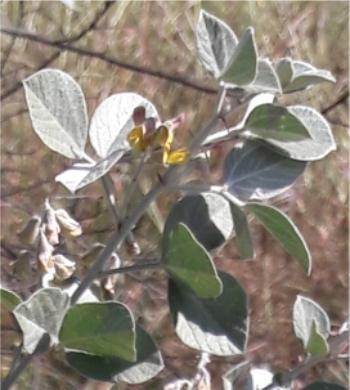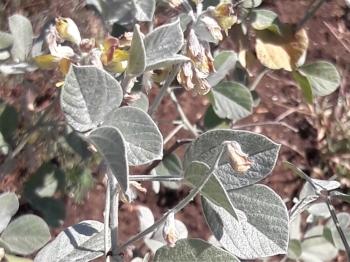Rhynchosia albissima
Rhynchosia albissima Gand.
Family: Fabaceae
Common names: silver snoutbean
Introduction
A bright yellow-flowered, robust and erect indigenous herb, velvety with silvery grey hairs. Its roots are used in traditional medicine to treat male impotence, induce labour in child delivery and also as a purgative.

Description
Description
Rhynchosia albissima is a robust, erect subshrub or woody herbaceous perennial, 0.3–3 m high. The stems are pubescent, the younger branches densely pubescent with silvery or grey velvety hairs.

The leaves are trifoliolate; leaflets terminal, usually elliptic to obovate or rhombic, 14–42 × 10–30 mm, paler beneath, densely pubescent to velvety with silver-grey hairs on both sides; venation prominent on the abaxial side; petiole 10–35 mm long; stipules ovate-lanceolate, 2–6 × 1–2 mm, pubescent.

The inflorescences in axillary or terminal racemes, dense, 30–170 mm long, pubescent. The flowers are 6–10 mm long, yellow with brown or maroon venation on petals, pubescent. The fruit is a pod, oblong-falcate, 12–22 × 4–6 mm, covered with silvery grey hairs.
Flowering time is from early spring, through summer to autumn (August-May).
Conservation Status
Status
According to Raimondo et al. (2009), Rhynchosia albissima is Red Listed as LC (Least Concern), as evaluated against the five IUCN criteria.

Distribution and habitat
Distribution description
Rhynchosia albissima is widespread from northeast South Africa into Mozambique and Zimbabwe, northwards to the East African region, including Uganda, Tanzania, Kenya and Somalia (Verdcourt 2001). In South Africa, it occurs in Limpopo, North West, Gauteng, Mpumalanga and KwaZulu-Natal Provinces. It is also found in Swaziland. It grows in grasslands, woodlands, near streams, gulleys and ditches and prefers black, loamy-clay soils.

Derivation of name and historical aspects
History
The name Rhynchosia is derived from the Greek word rhynchos, meaning a ‘beak’, ‘snout’ or ‘horn’, referring to the keel of the flowers. The specific name albissima, means ‘whitest’ or ‘densely white’ in reference to the conspicuous silvery grey hairs on the stem, leaves and flowers of the plant.

Ecology
Ecology
There is no ecology information recorded in literature on Rhynchosia albissima.
Uses
Use
Rhynchosia albissima is an important plant in traditional medicine on the African continent. A root decoction (mixed with Tetracera boiviana) is drunk to treat male impotence. The dried powdered roots can also be taken with porridge. In Tanzania, the root decoction of ‘Mzirapeku’ (R. albissima mixed with Tetracera boiviana) is given to expectant woman who have passed the normal pregnancy term of 9 months to induce labour in child delivery. Rhynchosia albissima is also used a purgative, where 250 grams of roots are boiled with 1 gram glass of water, then 1 glass of milk is added and the decoction is then drunk in the morning.
Growing Rhynchosia albissima
Grow
In its natural habitat, Rhynchosia albissima is a fairly moderate grower. There is no evidence of this species being cultivated in gardens. Users of this plant usually harvest it from the wild.
References
- Baker, E.G. 1923. Revision of South African species of Rhynchosia. Bothalia 1: 113–138.
- Clarke, H. & Charters, M. 2016. The illustrated dictionary of southern African plant names. Flora & Fauna Publications Trust, Jacana, Johannesburg.
- Foden, W. & Potter, L. 2005. Rhynchosia albissima Gand. National Assessment: Red List of South African plants version 2017.1. Accessed on 2018/08/08.
- Germishuizen, G. 2006. Rhynchosia. In G. Germishuizen, N.L. Meyer, Y. Steenkamp & M. Keith, A checklist of South African plants. Southern African Botanical Diversity Network Report No. 41. SABONET, Pretoria, pp. 488–490.
- Hedberg, I., et al. 1983. Inventory of plants used in traditional medicine in Tanzania, II. Plants of the families Dilleniaceae–Opiliaceae. Journal of Ethnopharmacology 9: 105–128. Elsevier Scientific Publishers, Ireland.
- Lima, C.C., Lemos, R.P.L. & Conserva, L.M. 2014. Dilleniaceae family: an overview of its ethnomedicinal uses, biological and phytochemical profile. Journal of Pharmacognosy and Phytochemistry 3 (2): 181–204.
- Neuwinger, H.D. 2000. African traditional medicine: a dictionary of plant use and applications. MedPharm, Scientific Publishers, Stuttgart.
- Verdcourt, B. 2001. Rhynchosia. In G.V. Pope & R.M. Polhill, Flora zambesiaca, vol. 3 (5): 168–210. Royal Botanic Gardens, Kew.
Credits
M.S. Mothogoane
National Herbarium, Pretoria
September 2018
Plant Attributes:
Plant Type: Shrub
SA Distribution: Gauteng, KwaZulu-Natal, Limpopo, Mpumalanga, North West
Soil type: Clay, Loam
Flowering season: Spring, Early Summer, Late Summer, Autumn
PH: Neutral
Flower colour: Yellow, Orange
Aspect: Full Sun
Gardening skill: Challenging
Special Features:
Horticultural zones










Rate this article
Article well written and informative
Rate this plant
Is this an interesting plant?
Login to add your Comment
Back to topNot registered yet? Click here to register.